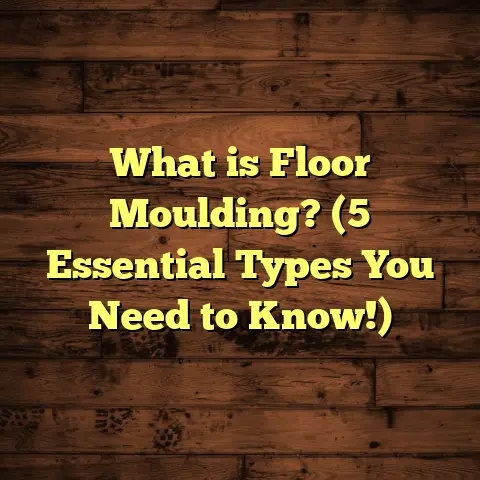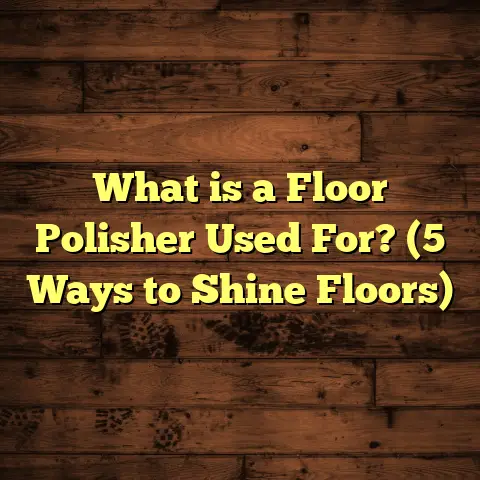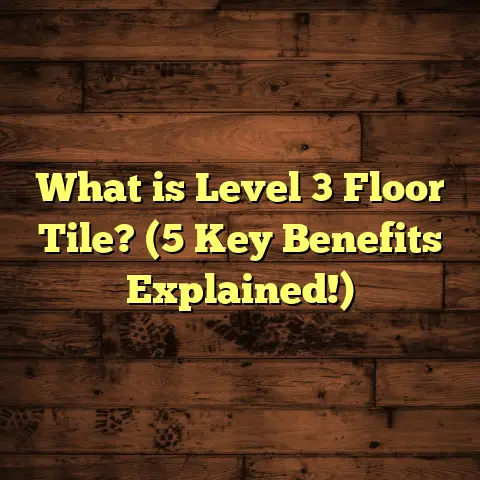What is Crowning on Hardwood Floors? (5 Signs You Shouldn’t Ignore)
What is Crowning on Hardwood Floors?
Have you ever walked into a room and noticed that your hardwood floor doesn’t look flat anymore? Maybe you saw some planks that looked like they were curving up in the middle, almost like tiny hills or crowns. That’s crowning. It’s a type of wood flooring issue that can sneak up on you and cause both visual and functional problems. As someone who has worked with hardwood floors for over a decade, I’ve seen my fair share of crowning—and it’s not just a minor cosmetic issue.
Crowning happens when the middle of a hardwood plank swells or expands more than the edges, causing the plank to bend upward. This can create uneven spots on your floor that are noticeable when you walk across them. It might feel like walking over a speed bump instead of a smooth surface. But why does this happen, and how can you tell if your floor has it?
Let me break it down for you.
The Nature of Wood and Moisture
Hardwood is a living material. It’s made from trees that absorb and release moisture depending on the environment. When hardwood planks are installed in your home, they come with a certain moisture content balanced to the current surroundings. But if that balance changes—say, because of high humidity or water exposure—the wood will react.
When moisture gets trapped underneath a plank or unevenly absorbed through the wood, it causes something called moisture imbalance. The bottom side of the plank swells more than the top. Because the bottom is expanding, it pushes the middle of the board upward, resulting in crowning.
Crowning vs. Other Hardwood Issues
It’s easy to confuse crowning with other wood problems like cupping or buckling. Here’s how you can tell them apart:
- Cupping: The edges of the plank curl up higher than the center, creating a “U” shape.
- Crowning: The center of the plank rises above the edges, making an “n” shape.
- Buckling: Entire sections of flooring lift off the subfloor, often due to severe moisture.
Understanding these differences is key to knowing what your floor needs.
Why Crowning Can Sneak Up on You
One tricky thing about crowning is that it often develops slowly. You might see subtle changes at first—like slight bumps or small gaps between boards—then brush it off. But over time, if moisture isn’t addressed, those small signs can grow into bigger issues.
I had a client who ignored early crowning signs because they thought it was just seasonal expansion. Months later, parts of their floor started to buckle and required expensive repairs. That’s why spotting crowning early is crucial.
5 Signs You Shouldn’t Ignore Crowning on Hardwood Floors
So how do you know if your hardwood floor has crowning? Here are five signs I always tell homeowners to watch for:
1. Planks Curving Upwards in the Middle
If you get down low or run your hand over the floor, you might feel or see planks that aren’t flat anymore. Instead of lying flush with adjacent boards, the middle part curves upwards. Sometimes this looks like a gentle arch; other times it’s more pronounced.
In one project I worked on, a client’s newly installed floor started showing tiny ridges along several planks just weeks after installation. When I inspected, I realized the wood hadn’t been acclimated long enough and moisture had gotten underneath during installation—classic crowning.
2. Gaps Forming Between Boards
You might notice gaps appearing between boards even though crowning causes swelling in the middle of planks. This happens because as the center swells upward, it pushes edges apart where boards meet.
One homeowner thought their floor was shrinking because of visible gaps but it turned out the middle bulging was forcing edges apart. This kind of confusion is common when crowning isn’t understood well.
3. Squeaking or Creaking Noises
Elevated plank centers don’t sit right against nails or adhesive anymore. That movement can cause creaks or squeaks when you step on those spots.
I’ve heard many complaints from customers about noisy floors only to find crowning underneath as the root cause. Fixing crowning early can reduce annoying sounds and prevent further damage.
4. Moisture or Water Damage Nearby
If you see water stains, mold, or dampness near your hardwood floors—especially in basements, kitchens, or bathrooms—crowning might be developing soon if it hasn’t already.
I remember working on a Victorian-era home where basement flooding caused widespread crowning in their oak floors upstairs due to moisture wicking through joists. Moisture monitoring is key in preventing this.
5. Changes in Floor Height Measured With Tools
Sometimes crowning is not obvious to the eye but can be detected using tools like straightedges or feeler gauges. If you measure a rise of 1/16 inch or more in plank centers compared to edges, you’re likely dealing with crowning.
In my experience, any deviation over 1/32 inch should be seriously looked at before it worsens.
What Happens If You Don’t Address Crowning?
You may ask: “Is crowning really that big of a deal?” Honestly, yes—it can cause a lot more trouble than just an uneven floor.
Here’s what happens when crowning goes unchecked:
Cracking and Splitting Boards
The pressure created by swelling in the middle stresses wood fibers. Eventually, these fibers crack or split under strain.
During one job, I saw planks with noticeable splits along their length where crowning had been ignored for months.
Buckling and Lifting Floors
Crowning puts upward pressure on boards which can eventually lead to full buckling—where entire sections pop off the subfloor.
This is more expensive to fix since flooring has to be removed and replaced.
Subfloor Damage
Moisture trapped under floors doesn’t just affect wood planks—it can also damage plywood or concrete subfloors over time.
Unchecked moisture causes rot or mold growth beneath your feet.
Difficult Cleaning and Furniture Movement
An uneven floor makes vacuuming or moving furniture awkward and potentially damaging to your floors.
I once had a client who scratched their furniture legs trying to push chairs over raised planks caused by crowning.
Lower Home Value
Damaged floors are big turnoffs for buyers and inspectors alike. If you plan to sell your home one day, ignoring crowning could hurt resale value.
How I Diagnose Crowning When Called In
When a homeowner calls me about uneven floors or noises, here’s how I approach diagnosing crowning:
Step 1: Visual Inspection
I get down on hands and knees to closely inspect individual planks for curvature signs. Using a flashlight helps spot shadows highlighting uneven surfaces.
Step 2: Moisture Testing
I use pin and pinless moisture meters on both flooring surface and subfloor to identify moisture imbalances causing crowning.
Step 3: Measure Height Differences
Using a straightedge and feeler gauge, I measure plank center height against edges at multiple points to quantify how severe crowning is.
Step 4: Environment Assessment
I check relative humidity levels inside home using hygrometers and look for plumbing leaks or poor ventilation sources.
Step 5: Review Installation History
I ask about wood acclimation times and whether moisture barriers were used during installation—common factors leading to crowning.
How I Fix Crowning: A Step-by-Step Guide
Depending on severity and cause, fixing crowning can range from simple fixes to complete plank replacement:
Step 1: Eliminate Moisture Source
This is non-negotiable. Fix leaks, improve drainage, add vapor barriers under floors and increase airflow beneath subfloor if needed.
For one flooded basement job I did recently, we installed sump pumps and vent fans which stopped further moisture intrusion immediately.
Step 2: Stabilize Indoor Humidity
Using dehumidifiers or HVAC adjustments, maintaining indoor humidity between 30%-50% helps wood stabilize naturally.
Proper acclimation before installation also plays a major role here.
Step 3: Light Sanding for Mild Crowning
If crowning is minor, sometimes sanding down raised plank centers helps level surface without replacing wood.
I always caution clients not to sand too deep since it weakens boards and reduces lifespan.
Step 4: Replace Severely Crowned Boards
Boards with severe bowing usually need removal and replacement after correcting moisture issues beneath.
Using quality adhesives and allowing proper acclimation improves long-term results.
Step 5: Monitor Floors Post-Repair
After repairs, I recommend regular moisture monitoring during seasonal changes to catch any recurring problems early.
Tips From My Experience to Prevent Crowning Before It Starts
Here are some practical tips I share with homeowners based on years installing hardwood floors:
- Acclimate Wood Properly: Let wood sit in installation area for 3–7 days depending on species and climate.
- Use Moisture Barriers: Especially over concrete subfloors to block vapor migration.
- Control Indoor Humidity: Keep between 30%–50% year-round for stable wood conditions.
- Inspect Plumbing Regularly: Catch leaks before they soak subfloors.
- Avoid Hardwood in High-Moisture Areas: Unless specifically designed for such environments.
- Ensure Proper Installation: Tight joints help prevent water infiltration.
- Ventilate Crawl Spaces: To reduce trapped moisture under floors.
- Use Professional Installation: Experienced installers spot potential issues early.
A client once told me their floors have never warped because they follow these guidelines religiously—and their home feels more comfortable too!
Data and Insights Backing Up What I’ve Seen in Practice
Here are some stats from industry sources like NWFA (National Wood Flooring Association) and research studies that confirm what my experience shows:
| Factor | Statistic |
|---|---|
| Callbacks due to moisture issues | Around 30% of hardwood flooring callbacks |
| Reduction by Proper Acclimation | Up to 75% fewer installation defects |
| Effect of Humidity Control | 80% fewer warping/crowning problems |
| Crowning Cases from Subfloor Moisture | Approximately 40% in damaged floor studies |
These figures highlight how critical moisture management is for hardwood longevity.
Case Study: Historic Home Crowning Rescue
A client owning an early 1900s Victorian house called me when their newly refinished oak floors began buckling after heavy rains caused basement flooding. The planks showed clear crowning with visible gaps between boards and raised centers.
We performed thorough moisture testing revealing high vapor levels under floors plus poor drainage outside causing water seepage. After installing a high-quality vapor barrier underfloor along with sump pumps outside foundation walls, we replaced only severely affected planks using engineered wood designed for moisture resistance.
Six months later, humidity levels stabilized at 45%, floors laid flat without squeaks or gaps, and client reported no further issues despite seasonal weather swings—a solid example showing why addressing root causes first matters most.
Answering Your Questions About Crowning on Hardwood Floors
Q: Can I fix crowning myself?
If it’s minor, light sanding might help but be cautious not to damage boards. For anything moderate or worse, professional inspection is best since moisture problems often underlie the issue.
Q: Can engineered hardwood crown?
Yes, but less often than solid hardwood because engineered boards are more dimensionally stable due to their layered construction.
Q: How long does it take for crowning to develop?
It varies widely—sometimes weeks after installation if moisture intrusion occurs; other times months or years depending on environment changes.
Q: Is crowning covered under warranty?
Many manufacturers exclude damage caused by improper acclimation or moisture issues from warranties—always check terms carefully.
Final Thoughts From My Hardwood Floor Journey
Crowning is one of those flooring challenges that homeowners often overlook until it becomes obvious—and costly—to fix. Watching out for early signs like curved planks or squeaks can save you headaches later.
Moisture control is key whether you’re installing new hardwood or maintaining old floors. Taking proactive steps like proper acclimation and humidity management pays off over time with beautiful flat floors that last decades.
If you’re seeing signs of crowning in your home now, don’t wait! Reach out for professional advice tailored to your situation before damage escalates.
Got questions about your floors? Feel free to ask—I’m always happy to share what I’ve learned from years working hands-on with hardwood flooring!





